| Published
on 16
Jul
2016 |
All rights reserved.
|
|
Giulia Quadrifoglio
|
|
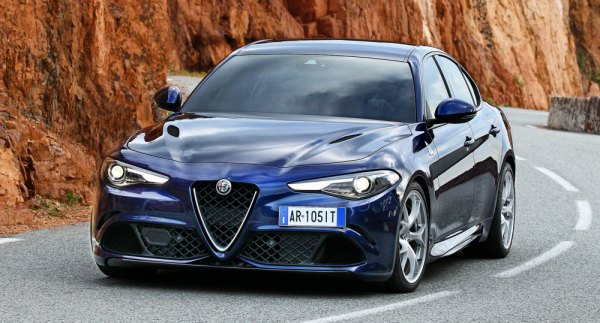
|
I have to admit that I am
always biased towards emotional Italian cars, even though they might
come
with many flaws. Alfa Romeo was one of my preferences. Reviewing my
writings in the past will find many Alfa Romeos got my highest regards,
including 159 and Brera which were eventually proved to be commercial
failures. 147, 156 and Giulietta fared better, but neither delivered
the sales success promised by Alfa. In fact, throughout the last 2
decades Alfa has been on a declining trend. Its sales dropped from the
level of 200,000 units a year at the beginning of the century to just
68,000 units in 2014, which is simply a joke for a mass production
brand. At present, its model line-up consists of only a B-segment
supermini, MiTo, and a C-segment hatchback, Giulietta, plus a
low-volume sports car, 4C. Most of them are already very old and due
for replacement. Parent company FCA talked about reviving Alfa Romeo,
its jewel of the crown, times after times but the actual execution was
delayed again and again. It must be heartbreaking to Alfistis...
Finally, this day has come with the launch of Giulia! This all-new
mid-size sedan not only ends Alfa's starvation for new production model
in the past 6 years but it also kickstarts an ambitious turnaround plan
which will involve an investment of 5 billion euros and bring another 5
models: a Giulia-based mid-size crossover, a large sedan replacing 166,
a large crossover, a Giulietta replacement and a coupe/spider. FCA once
talked about 400,000 units of sales by 2018, which is incredible. It
might have been scaled down a bit by now, but no doubt this is still
the largest turnaround Alfa Romeo received since it was privatized by
Fiat in 1986.

|
The new Giulia is an overdue replacement for 159, whose
production ended 5 years ago. This means it is a direct rival to BMW
3-Series, Audi A4, Mercedes C-class and Jaguar XE etc. It is well sized
to do so, measuring 4.64m long, 1.86m wide and 2.82m in wheelbase,
making it on a par with its rivals. However, the most important is that
it is built on a rear-wheel-drive platform adapted from that of
Maserati Ghibli. Yes, this is the first rear-drive Alfa since the
strange-looking-but-lovely Alfa 75 said goodbye to us in 1992, so
you can see it is put in a stronger position than even
the award-winning 156 to challenge the German establishment.
Its straight-four or V6 engines are mounted longitudinally and drive
the rear axle (Q4 is optional, like Maserati). The
cab-rearward proportion guarantees 50:50 weight distribution which is
key to the claim of class-leading handling. Suspensions are
sophisticated, too, with double-wishbones up front and multi-link at
the rear, supplemented with ZF Sachs continuously adaptive dampers.
Moreover, its chassis
employs a lot of aluminum parts to cut weight, including front and rear
subframes, front suspension domes, bonnet, doors and fenders.
The car is stylish, too. Its nose is full of Alfa Romeo’s signature
elements, which bring a strong sense of Italian passion. The body
profile is also distinguishable from other cars in the segment as it is
slightly rounder, if not as round as 156. Speaking of 156, it is still
the benchmark of Alfa saloon design, and the Giulia is yet to match its
aesthetic, or design integrity, or originality. In fact, there are
signs of BMW’s influence at the side windows and C-pillars of Giulia.

|
Now let’s concentrate on the hottest Giulia Quadrifoglio,
because unusually this is the first Giulia model launched to the public
– it certainly makes the best use of halo effect to promote the regular
Giulias. Quadrifoglio might sound new to us, but it is the Italian for
Cloverleaf, a nameplate used to represent the high-performance Alfas in
English-speaking markets. However, the company has decided to unify the
nameplates thus it will be called Quadrifoglio worldwide. From its
aggressive looks, you can already tell that it is a fearsome rival to
BMW M3 and Mercedes-AMG C63 S. Previous fast Alfa sedans, even as hot
as 156 GTA, were never running in the league of BMW M3. The Giulia
Quadrifoglio is very different. It was developed by ex-Ferrari engineer
Philippe Krief, who was transferred from Maranello to lead the
development of the whole Giulia program. BTW, his last project was the
458 Speciale, so there is no question about his qualifications. This
car has a Ferrari-derived twin-turbo V6 with output as high as 510
horsepower, good enough to overshadow M3 by nearly 80 horsepower, good
enough to match the much larger twin-turbo V8 of Mercedes, and good
enough to power a new Ferrari Dino I would say! Its performance is
equally startling – 191 mph top speed and 0-60 mph in merely 3.8
seconds, faster than its German rivals! And not just on straight, but
also at the very backyard of the German cars. It lapped Nurburgring
Nordschleife in 7 minutes
and 39 seconds, 14 seconds clear of the M3! Forget about Cadillac
ATS-V, this is the worst nightmare to the German! (Update on
2016-09-09: Giulia QF automatic has just rewritten the record again
with a lap time of 7 min 32 sec)
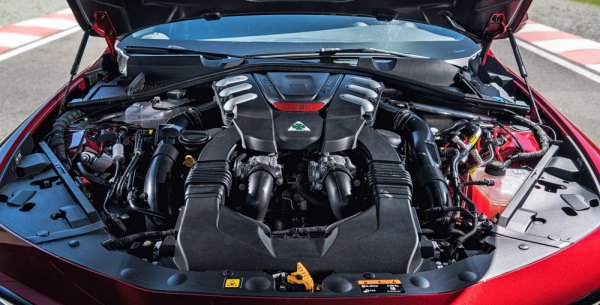
|
Open the long carbon-fiber bonnet, hiding under that ugly
plastic cover is the 2.9-liter twin-turbo V6. Officially, it is said to
be “inspired by Ferrari”. Unofficially, it is practically the
6-cylinder derivative of the
F154 V8 powering Ferrari California T and 488 GTB. It was developed by
the same Ferrari man, Gianluca Pivetti. The connection with Ferrari's
latest turbocharged V8 is even stronger than the Maserati V6 since it
shares the same 90-degree V-angle (Maserati V6 opted for 60 degrees for
smoother operation), which also enables a lower center of gravity. The
forged steel
crankshaft is no longer flat-plane, of course, as this configuration is
simply impossible on a V6. Another difference is the addition of
cylinder deactivation, which shuts down one cylinder bank
at part load to save fuel. However, the rest of the engine shares a lot
with Ferrari, such as the same 86.5mm bore and 82mm stroke as
California T, direct injection, intake and exhaust VVT and forged
aluminum pistions. Both turbochargers also
come from IHI, although their specifications might be different. Unlike
the “hot-V” architecture preferred by German manufacturers,
Ferrari keeps the turbos at either side of the engine
to free up space for cooling. This explains why it can employ a higher,
1.4 bar boost pressure without overheating other engine components.
That peak boost pressure slots between California T (1.3 bar) and 488
GTB (1.5 bar), so the Alfa V6 is downsized but by no means
detuned. In fact, its specific output of 176.4 hp/liter is even higher
than the 171.7 hp/liter of 488 GTB, incredible!
It is not as revvy as the Ferrari V8s though. Because of the bulkier
crankshaft as well as deliberate tuning, its fuel cut-off is set at
7250 rpm, decent rather than remarkable. The peak power is released
even earlier at 6500 rpm. Peak torque of 442 pound-foot arrives at 2500
rpm and sustains for the next 3000 rpm. On paper, its power delivery is
more like conventional turbocharged motors. In the real world, however,
it feels rather different. The power is delivered in a more linear
manner. It isn’t as boosty as BMW M3 at lower revs, but like Ferrari it
has precious little turbo lag, and it punches harder and harder as rev
rises. The engine management system deliberately limits boost level so
that it keeps the rev-hungry character of good old naturally aspirated
motors. It is smoother and more enthusiastic to visit the rev limiter
than the M3’s straight-six. On the downside, this linear supply makes
it feel less punchy at times. The exhaust note is also too tamed
compared with AMG V8 or its Ferrari cousins, even though it is more
tuneful than BMW's.
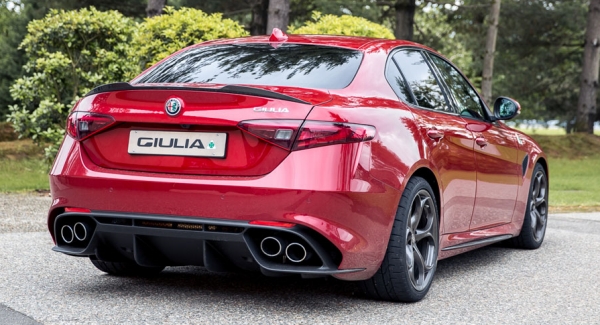
|
The 6-speed manual has a
notchy gearshift and a
cheap gear knob to discourage your usage, so it is better to opt for
the 8-speed ZF automatic, whose ratios are closely stacked and response
is second only to the
best DCTs. Moreover, its large aluminum paddles
look delicious and feel great in hands.
Weighing 1580 kg in manual form or just over 1600 kg with automatic,
the Giulia QF is heavier than an M3 but lighter than pretty much
everything else. This must thanks to the extensive use of carbon-fiber
– the bonnet, the roof, prop shaft, front splitter, side skirts,
diffuser and even the front seats. The optional carbon-ceramic brakes
save
weight and offer a fade-free braking performance.
You seat low in the QF. The driving position is near perfect, something
you won’t expect for an Alfa. The part-leather, part-Alcantara bucket
seat wraps you well. There’s a wide range of adjustment for the
steering wheel, too. Another surprise is the generous amount of room
available, especially the rear legroom, which is not always the case
for a mid-size Alfa saloon. This means it is now on a par with BMW.
Boot space is also competitive. Not so good is build quality. No matter
materials, switchgears or fit and finish, it’s more Jaguar XE than
German-grade. Fortunately, the dashboard design is stylish enough. The
instrument is housed within a pair of large round pods. The circular
air vents and the steering-wheel-mounted starter button have Ferrari
flavours. It feels sportier and more special than the norm of the
class. The infotainment system is a bit disappointing though, as its
screen is quite small and its graphics lack clarity. The menus are not
easy enough to navigate through the rotary dial on transmission tunnel.
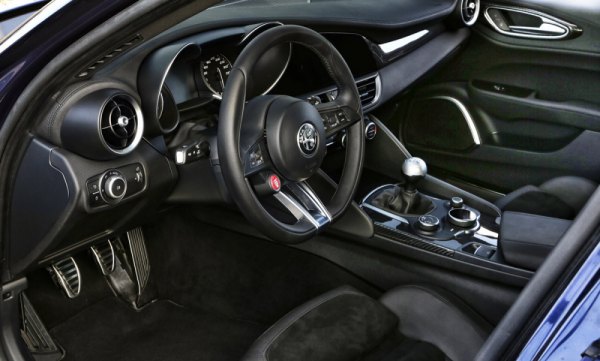
|
Another rotary knob on the transmission tunnel is the DNA
switch. It offers four modes – Dynamic, Normal, Advanced Efficiency
(which enables cylinder deactivation) and, unique to the Quadrifoglio,
Race mode. The latter turns off ESP completely to allow cornering
sideway, as well as dialing the throttle, transmission, steering and
active rear differential (another device exclusive to the QF) to the
extreme settings. Wisely, the adaptive dampers are controlled
separately to suit different roads.
While German performance saloons ride on stiff suspension in pursuit of
tight body control and maximum grip, the Alfa is quite different. Its
suspension is softer and more absorbent. It shows more body roll in
corner, inevitably, but the roll angle actually gives you a clearer
picture about the state of cornering, much like (but less dramatic
than) a Mazda MX-5, so you feel more connected to the car. Despite of
more roll, its double-wishbone suspensions keep the front tires
gripping hard on the road and resisting understeer remarkably. It also
enables a sharp turn-in. In Alfa’s (or Ferrari’s) fashion, the steering
rack is geared very fast at just over 2 turns from lock to lock, but
thanks to its swiss-watch precision it doesn’t feel nervous. Although
it has little feel to speak of (as do most rivals nowadays,
admittedly), the fast steering does compensates the soft suspension and
lifts the driving excitement.
The chassis feels very well balanced and agile, probably more so than
BMW M3. Whether it is due to the 50:50 weight distribution or the
effect of the active differential is hard to tell, but it feels light
and neutral. Disable the safety net by turning on Race mode, you will
discover its great fundamental. Now you can throttle steer the car. It
is again friendlier than the M3. It doesn’t need to push as hard to
start sliding, yet the drift is far more progressive. The linear power
delivery helps you to adjust the drift angle. Moreover, should you
overdone the throttle, you can easily catch it with the quick steering.
In comparison, the M3 feels far edgier to do the same drift. Mercedes
C63 drifts as well as Alfa, but it is not as agile.
So here is another 5-star Alfa Romeo. Yes, it has many rough edges as
all Alfas do, such as the average interior build quality, the mediocre
infotainment system, the subdue exhaust note or the suspicious
reliability. Its V6 is not as mad as AMG's V8 either. However, this is unquestionably
the greatest and the best developed
Alfa Romeo
we have seen in... well, ever since we started watching cars. What a
great start of a new era!
|
Verdict:      |
Published
on 16
Jul 2016
|
All rights reserved.
|
|
| Giulia |
|
What about the
lesser
Giulia models? We have already covered the background and basic
engineering details in the review of Quadrifoglio (read
above if you haven’t). The mainstream models share most of its goodies,
if not the twin-turbo V6, active differential or ceramic brakes.
Predictably, those expensive carbon-fiber parts are skipped on the mass
production models, but they use
plenty of lightweight aluminum items, such as the bonnet, fenders,
doors, suspension subframes and front suspension domes. These keep the
car relatively light and guarantee the same 50:50 weight distribution
as the high-performance version.
As for engines, all are newly developed four-cylinder units. There is a
pair of 2-liter
petrol with MultiAir II variable valve timing and lift system, direct
injection and a
twin-scroll turbocharger, one produces 200 hp and 243 lbft of torque
while another 280 hp and 295 lbft. The latter is good enough to teach
the 252 hp BMW 330i a lesson. Likewise, the all-alloy 2.2-liter
turbo diesel has two states of tune, i.e. 150 hp or 180 hp, both are
served with abundance of torque. There might be a VM Motori-sourced
3-liter diesel V6 coming in the future (like Maserati Ghibli), but even
if it gets the greenlight it won’t be a mass seller. More hope shall be
put on a higher power version of the four-cylinder diesel, which is
believed to produce about 210 hp. All these engines are mated to the
excellent ZF
8-speed automatic.
The 2.0 MultiAir turbo is smooth, flexible and quite responsive for a
turbo, but it is not designed to rev like a true Alfa twin-cam. In
fact, the electrohydraulic MultiAir mechanism robs the space for a
second camshaft, so it has only one camshaft driving directly the
exhaust valves and operating the intake valves through hydraulic
actuators. No wonder it revs no more than 6000 rpm, while peak
horsepower arrives at a modest 5500 rpm. That said, forget its Alfa
badge and you will find it a delightful companion for everyday driving.
When you need, it offers plenty of overtaking power and emits a sporty
exhaust growl. When settled in motorway cruising, it is quiet and
invisible.
Comparatively, the diesel engine is more disappointing. It starts with
an old-fashioned diesel clutter. No matter at idle or working under
full load, it produces too much noise and vibration. Fortunately, the
automatic transmission tends to keep rev at the mid-range where it is
quieter and smoother yet delivers the strongest torque. Overall, it is
on a par with Jaguar’s Ingenium diesel but not up to the league of BMW,
Audi and Mercedes’ latest diesel engines.
Like Quadrifoglio, the lesser Giulias have a great chassis. It is
agile, well balanced and stable in corner. Body roll is limited, but
the suspension still soaks up speed bumps and potholes brilliantly.
This combination of control, agility and suppleness matches Jaguar XE
and beats all its German rivals. The steering, however, is not as great
as Jaguar. It is too quick and too aggressive for the likes of most
drivers, while feedback is too thin. That said, its responsive turn-in
does highlight the agility of the chassis. There is outstanding
front-end grip thanks to the optimized front suspension geometry. This
allows the Giulia to corner swiftly without being troubled by early
understeer. Try this on a 3-Series!
The ride and handling of the regular Giulia is surprisingly similar to
the Quadrifoglio. Yes, it does not have the immense traction and grip
generated by the beefy Pirelli P-Zero Corsa rubbers, nor the astounding
stopping power of ceramic brakes, nor the foolproof effectiveness of
active differential, but the inherent balance and the tuning philosophy
are just the same. One thing does separate them though – the Race mode.
Without it, the regular Giulia approaches its cornering limit with a
gentle understeer. Since there is no other way to turn off the
stability control, the Giulia fails to oversteer. What a pity, because
we know its chassis is able to handle beautiful drift. It could have
been more fun to drive.
Inside, losing the sporty bucket seats, Alcantara and carbon-fiber
trims of QF, the regular Giulia feels less special. As a result, its
deficiencies in quality and attention to details become more obvious.
Still, it offers plenty of room for 4, a sounded driving position,
comfy seats and good all-round visibility. The structure feels solid
and the noise insulation is excellent. In addition to the absorbent
suspension, refinement is surprisingly high. You would not have
imagined an Alfa to cruise at 100 mph with such a minimal fuss.
That leaves build quality to be the most worrying. The Giulia is being
built at Fiat’s Casino plant which used to produce Fiat Bravo and
Lancia Delta, both were not renowned for quality. Originally it was
scheduled to start production last November, but that was pushed back
for 5 months because of quality issues. In fact, Philippe Krief, who
was responsible for its development, quit his job in February, which
reflected not only the iron fist of Sergio Marchionne but also the
scale of its problems. Codenamed Giorgio, the car was developed in a
record-breaking 33 months as Marchionne was pushing hard. Perhaps too
fast.
|
Verdict:     |
Published
on 7
Sep 2021
|
All rights reserved.
|
|
Giulia GTA and GTAm
|
|
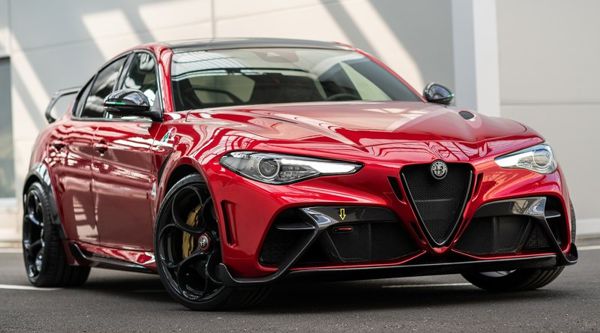
|
|
The
legendary nameplates are reborn, and they are lifted to new heights.
|
|
It is not the first time
Alfa Romeo uses these nameplates. Most recently, there were 147GTA and 156GTA in the early
2000s, but the track-oriented GTAm should date back
to the 1960s, when the original Giulia was really used as a race car.
However, none of these cars could compare with the new Giulia GTA and
GTAm. As good as the original GTA and GTAm were, they employed only
twin-cam 4-cylinder engines with 1.3 to 2.0 liters and output of up to
240 horsepower in racing trims. The 2000s GTAs used a road-going
3.2-liter V6 with 250 horsepower. The new GTA and GTAm? More than
double the horsepower, 0-60 mph in 3.5 seconds and a top speed of up to
191 mph. They are also extremely expensive. Built by hands in small
quantity – 500 units split between the two models – they are the
equivalent of BMW M4 GTS and Jaguar XE SV Project 8, costing between
£152,000 and £156,000. That makes the regular Giulia
Quadrifoglio a bargain at £67K, especially when you consider the
latter loses
only 30 horsepower.
If you think they are overpriced, look at their faces first. With those
carbon-fiber front splitters, winglets, extra vents and flared fenders
that cover 25mm wider front track and 50mm wider rear track as well as
larger, 20-inch single-lock forged alloy wheels, no other 4-door sports
sedans could look more exciting than the GTA… except the GTAm, whose
big
rear wing adds further aggression. Some of its track-oriented rivals
also feature big rear wings, but the Giulia has a flowing shape and a
sexy front end design only an Alfa Romeo could achieve. It feels like
moving and fire-breathing even when it is stationary, while a BMW GTS
and Jaguar Project 8 look just like, well, a 4-series and XE with wings.

|
|
GTAm
produces 300kg more downforce than the QF.
|
|
Externally, the chief difference between the GTA and GTAm is the rear
spoiler. The one on GTA is far more understated, just an extension from
the boot lid (although it is significantly larger than that of the QF),
while on the GTAm is a high-mounted rear wing. The aero foil of the
rear
wing and the front splitter on GTAm are manually adjustable. At their
sleekest positions, the car keeps the 191mph top speed of the QF. At
largest angle, it produces 300kg more downforce than the QF, and double
of the GTA. Both GTA and GTAm sport larger diffusers, thanks to moving
the quad-exhaust of QF to two centrally-mounted exhaust. The
aerodynamics are tuned with the help of Sauber, the operator of Alfa
Romeo F1 team.
The 2.9 twin-turbo V6 gets lighter con-rods, additional cooling oil
jets for pistons, remapped ECU and freer flowing Akrapovic titanium
exhaust. Output is boosted by 30hp to 540hp, though max. torque remains
unchanged at 442 lbft. Meanwhile, the ZF 8-speed automatic is remapped
to be more responsive. The powertrain might not feel significantly
different, but the extra sound of the titanium exhaust makes it even
more
thrilling. The sharp throttle response, the linear delivery and
enthusiasm for rev – qualities that make the Alfa-Ferrari V6 one of our
favourite engines in the world – remains intact.
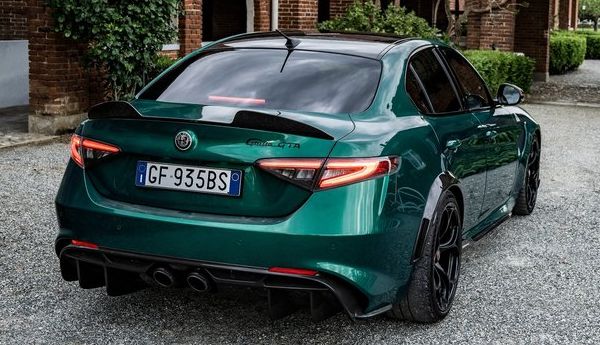
|
|
GTA
gets a more understated rear spoiler, but shares new diffusers with
GTAm.
|
|
However, as in the case of the original GTA and GTAm, the highlight has
to be weight reduction and chassis enhancement. The GTA employs
carbon-fiber front bumper, front fenders and rear fender extensions (in
addition to the bonnet, roof and prop shaft already found on the QF),
as well as Lexan side and rear windows and the aforementioned titanium
exhaust. These result in a loss of 40kg. Meanwhile, the GTAm cuts
another 40kg by
using Sabelt carbon-fiber racing buckets, lightweight rear door panels,
fabric door pulls (sounds like Porsche GT3) and by removing the rear
seat. A semi-roll cage is added in place of the latter for added
stregnth and trackday safety. At 1540kg, it
is 115kg lighter than the new BMW M3 Competition and 200kg lighter than
Jaguar Project 8, making it easily the lightest in its class. That
said, Alfa Romeo keeps all the creature comfort intact. If anything,
the Alcantara trims covering the dash top and headliner make the
interior even more delicious.
Apart from significantly wider tracks, the suspension has been lowered
and gets stiffer springs, dampers, roll bars and bushings. The wheels
have been enlarged by an inch, the front tires get 20mm wider, and in
combination with Michelin Cup 2 tires, grip should be much improved.
Last but not least, Brembo carbon-ceramic brakes provide enhanced
stopping power.
 |
|
While
you know Porsche will keep making better and better GT3s, Alfa could
take decades to repeat a magic like this.
|
|
Surprisingly, even as hardcore as it looks, the GTAm is not a hardcore
track car. It is far more forgiving and comfortable than imagined.
Unlike its German counterparts, Alfa does not tune its suspension too
stiff. You can drive it on daily basis just as comfortable as the
regular QF, which is already a supple-riding machine. Yes, there are
more exhaust roar, pops and crackles on overrun and more persistent
tire noises, but the GTAm does not sacrifice sound insulation, so
anyone describing it as a 4-door GT3 should eat their words. The new
BMW M3 Competition, for example, has a much stiffer ride. The Alfa
tackles
rough surfaces and mountain roads with ease as if nothing happens.
Mid-corner bumps fail to
affect its composure.
In fast corners, the GTAm grips harder and its downforce presses it
harder to the tarmac. It also brakes with the power expected for a
track car, but otherwise the handling character is familiar to the
drivers of QF. Its steering is light, quick and accurate, not very
feelsome but still the nose turns in eagerly. You feel the road and the
cornering limit from your seat of the pants and the car's body roll –
yes, it
rolls a little in corner like a QF, but this does not affect its
cornering prowess or balance. In fact, it balances beautifully. The
rear axle moves according to your throttle and braking, tightening the
line or oversteering progressively. Its chassis balance and all
controls work in harmony to make you feel part of the machine, so
intuitive and obedient. The free-revving V6, the responsive gearbox and
the roaring exhaust add to your smile.
This is the best Alfa Romeo driving
machine since, well, who remembers for how long? It is also one of the
best driving machines in the world. Not the most powerful, but
exceptionally engaging yet accommodating. The fact that it costs more
than a Porsche GT3 might raise some eyebrows, but the GTAs, especially
GTAm, feel even more special, and certainly far more comfortable and
usable than the new, stiff-riding GT3. More exclusive, too, as only 500
will be built. While you know Porsche will keep making better and
better GT3s, Alfa could take decades to repeat a magic like this.
|
Verdict:      |
Published
on 6
Jul 2023
|
All rights reserved.
|
|
Giulia Quadrifoglio (2023)
|
|

|
|
Subtle
revisions to the beautiful Alfa are sufficient to keep it at the sharp
end of sports sedan market.
|
|
Beautiful, quick and
agile, Alfa Romeo Giulia QF has been our favourite sports sedan for the
past 7 years. More recently, BMW M3 Competition takes the competition
to a higher level. It goes even quicker, harder and more surefooted on
tracks, so much so that many declared it the better car. Alfa needs to
respond with the 2023 update.
Outside, the new car gets a pair of new headlights whose shape is
unchanged – so that it fits into the existing body panels – but its
light cluster is modified, featuring 3 stylish C-rings. The
Shield-shape mesh grille is also said to be different, but too subtle
to my eyes to identify. Alfa Romeo has not altered the rest of the car,
as it is still easily the best looking of all.
Under the carbon-fiber bonnet, the same 2.9-liter twin-turbo V6 has
been retuned to deliver an extra 10 horsepower, though torque and power
delivery characteristics are unchanged, as are performance figures. You
might not be able to tell the extra shove, but the Alfa V6 is still a
work of wonder: free-revving, linear and responsive. It is not as
boosty as the M3 Competition engine, but that is exactly what makes it
so inspiring to stretch out.
Bigger changes are found in the chassis, which are introduced to sort
out the minor weaknesses on the old car. As good as the old car drove,
it was not as stable to attack a track as its German rival. That was
because of its relatively soft suspension setup, which delivered a
supple ride at the expense of body control, relatively. The updated car
gets stiffer anti-roll bars on both axles, and the adaptive dampers
have been recalibrated to be stiffer. Besides, the old car’s electronic
limited slip differential was sometimes inconsistent in its response,
thus failed to inspire as much confidence as in the M3 Competition. To
address this issue, Alfa simply replaced it with a conventional
mechanical LSD.
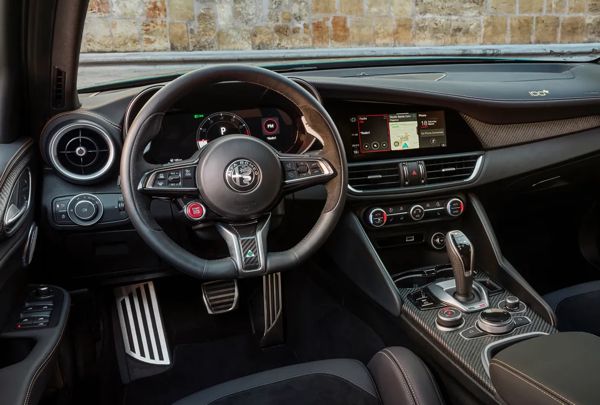
|
|
I
would rather have a beautiful car with a slightly cheap cabin than an
ugly car with an expensive interior...
|
|
On road or track, the updated QF loses none of its predecessor’s light
and agile feeling. Its steering is still ultra-quick, as is its turn-in
response. However, the stiffer suspension and mechanical diff takes
body control and stability to a higher level. The Alfa still absorbs
bumps more beautifully than its German counterpart, and therefore it is
a more comfortable car to drive day to day, but it has enough control
to allow you to attack back roads. The response of its mechanical diff
is more predictable, offering more traction and, crucially, more
confidence to push the car to its limit. If the brake pedal feel was
better and the automatic transmission was more responsive, it would be
perfect.
Another area where it fails to match BMW is interior. Despite the
materials upgrade in 2020, it still feels low-rent for a car costing
£78,000. The update narrows the gap significantly with some
cool-looking carbon-fiber trims, an HD digital instrument cluster and
an updated infotainment system, but to take the fight to BMW it
probably needs a complete overhaul. That said, I would rather have a
beautiful car with a slightly cheap cabin than an ugly car with an
expensive interior, that’s why I would choose the Alfa over BMW M3
every time.
|
Verdict:      |
|